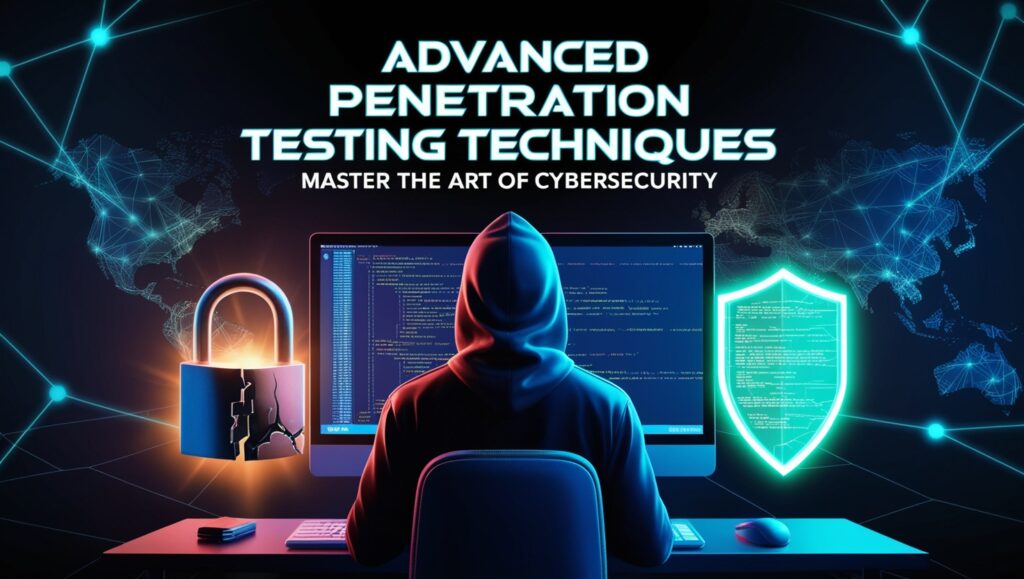1. Introduction to Advanced Penetration Testing
Advanced Penetration Testing Techniques is a proactive approach to identifying and exploiting vulnerabilities in systems, networks, and applications. Unlike basic penetration testing, which focuses on known vulnerabilities, advanced techniques simulate real-world attacks to uncover hidden weaknesses. This includes testing for zero-day vulnerabilities, advanced persistent threats (APTs), and sophisticated attack vectors. The goal is to provide organizations with actionable insights to strengthen their security posture and prevent potential breaches.

2. Reconnaissance and Information Gathering
Reconnaissance is the foundation of any penetration test. It involves collecting as much information as possible about the target to identify potential attack vectors.
- Passive Reconnaissance: This involves gathering data without directly interacting with the target. Examples include using Open Source Intelligence (OSINT) tools like Google Dorks, Shodan, or social media platforms.
- Active Reconnaissance: This involves directly interacting with the target, such as performing port scans using tools like Nmap or Nessus.
- Advanced Techniques: Using tools like Maltego for mapping relationships between entities or leveraging DNS enumeration to discover subdomains.
3. Vulnerability Scanning and Analysis
Once the reconnaissance phase is complete, the next step is to identify vulnerabilities in the target system.
- Automated Scanning: Tools like Nessus, OpenVAS, and Qualys are used to scan for known vulnerabilities. These tools provide a quick overview of potential weaknesses.
- Manual Analysis: Automated tools can miss complex or hidden vulnerabilities. Manual analysis involves digging deeper into the system, such as reviewing source code or testing custom applications.
- Prioritization: Not all vulnerabilities are equal. Advanced testers prioritize vulnerabilities based on their severity, exploitability, and potential impact on the organization.
4. Exploitation Techniques
Exploitation is the process of leveraging vulnerabilities to gain unauthorized access to a system.
- Zero-Day Exploits: These are vulnerabilities that are unknown to the vendor and have no available patch. Advanced testers may discover and exploit these vulnerabilities during a penetration test.
- Custom Exploits: Sometimes, off-the-shelf tools aren’t enough. Advanced testers write custom scripts or use frameworks like Metasploit to exploit specific vulnerabilities.
- Privilege Escalation: Once access is gained, testers may escalate privileges to gain administrative control over the system.
5. Post-Exploitation Tactics
After gaining access, the focus shifts to maintaining control and gathering valuable data.
- Persistence: Testers ensure they can maintain access even if the system is rebooted. This could involve creating backdoors or modifying system configurations.
- Lateral Movement: Testers move across the network to access other systems, simulating how an attacker might spread within an organization.
- Data Exfiltration: Testers may extract sensitive data to demonstrate the potential impact of a breach.
6. Web Application Penetration Testing
Web applications are a common target for attackers. Advanced techniques include:
- SQL Injection: Exploiting vulnerabilities in database queries to extract or manipulate data.
- Cross-Site Scripting (XSS): Injecting malicious scripts into web pages to steal user data or hijack sessions.
- API Security Testing: APIs are often overlooked but can be a goldmine for attackers. Testers look for vulnerabilities like insecure endpoints or lack of authentication.
7. Network Penetration Testing
Networks are the backbone of any organization, and securing them is critical.
- Protocol Exploitation: Testers target weaknesses in network protocols like FTP, SNMP, or Telnet.
- Wireless Testing: Assessing the security of Wi-Fi networks, including cracking encryption or exploiting misconfigurations.
- Firewall and IDS Evasion: Testers use techniques like fragmentation or encryption to bypass security mechanisms.
8. Social Engineering and Physical Security
Humans are often the weakest link in cybersecurity.
- Phishing: Crafting convincing emails or messages to trick users into revealing sensitive information.
- Physical Breaches: Gaining access to restricted areas to plant malicious devices or steal data.
- Insider Threats: Exploiting employees with access to critical systems, either willingly or unknowingly.
9. Evading Detection
To succeed, penetration testers must avoid detection by security systems.
- Anti-Virus Evasion: Modifying malware to bypass detection by anti-virus software.
- Encryption: Using encrypted channels to hide communications between the attacker and the compromised system.
- Steganography: Hiding data within images or other files to avoid detection.
10. Reporting and Communication
A penetration test is only as good as its report.
- Detailed Findings: Clearly documenting vulnerabilities, their impact, and steps to reproduce them.
- Executive Summary: Providing a high-level overview for non-technical stakeholders.
- Remediation Recommendations: Offering actionable steps to fix identified vulnerabilities.
11. Ethical and Legal Considerations
Penetration testing must be conducted ethically and legally.
- Authorization: Always obtain written permission before conducting a penetration test.
- Scope Definition: Clearly define the scope of the test to avoid unintended consequences.
- Compliance: Ensure the test complies with relevant laws and regulations.
12. Tools of the Trade
Advanced penetration testers rely on a variety of tools, including:
- Reconnaissance: Nmap, Maltego, Shodan.
- Exploitation: Metasploit, Cobalt Strike, Burp Suite.
- Post-Exploitation: Mimikatz, PowerShell Empire.
13. Case Studies and Real-World Scenarios
Learning from real-world breaches can provide valuable insights.
- Example 1: A case study on how a SQL injection vulnerability led to a major data breach.
- Example 2: How social engineering was used to gain access to a corporate network.
14. Continuous Learning and Improvement
Cybersecurity is a constantly evolving field.
- Stay Updated: Follow industry news, attend conferences, and participate in training programs.
- Capture the Flag (CTF): Participate in CTF competitions to hone your skills.
- Certifications: Pursue advanced certifications like OSCP, CISSP, or CEH.
15. Conclusion
Advanced Penetration Testing Techniques are essential for identifying and mitigating sophisticated cyber threats. By following the steps outlined in this guide, organizations can strengthen their defenses and stay ahead of attackers.
16. FAQ Questions
- What is the difference between basic and advanced penetration testing?
Basic testing focuses on known vulnerabilities, while advanced testing simulates real-world attacks to uncover hidden weaknesses. - What tools are used in advanced penetration testing?
Tools like Nmap, Metasploit, Burp Suite, and Cobalt Strike are commonly used. - How often should penetration testing be conducted?
It depends on the organization’s risk profile, but at least once a year is recommended. - Is penetration testing legal?
Yes, as long as it is conducted with proper authorization and within the defined scope.

Leave a Reply